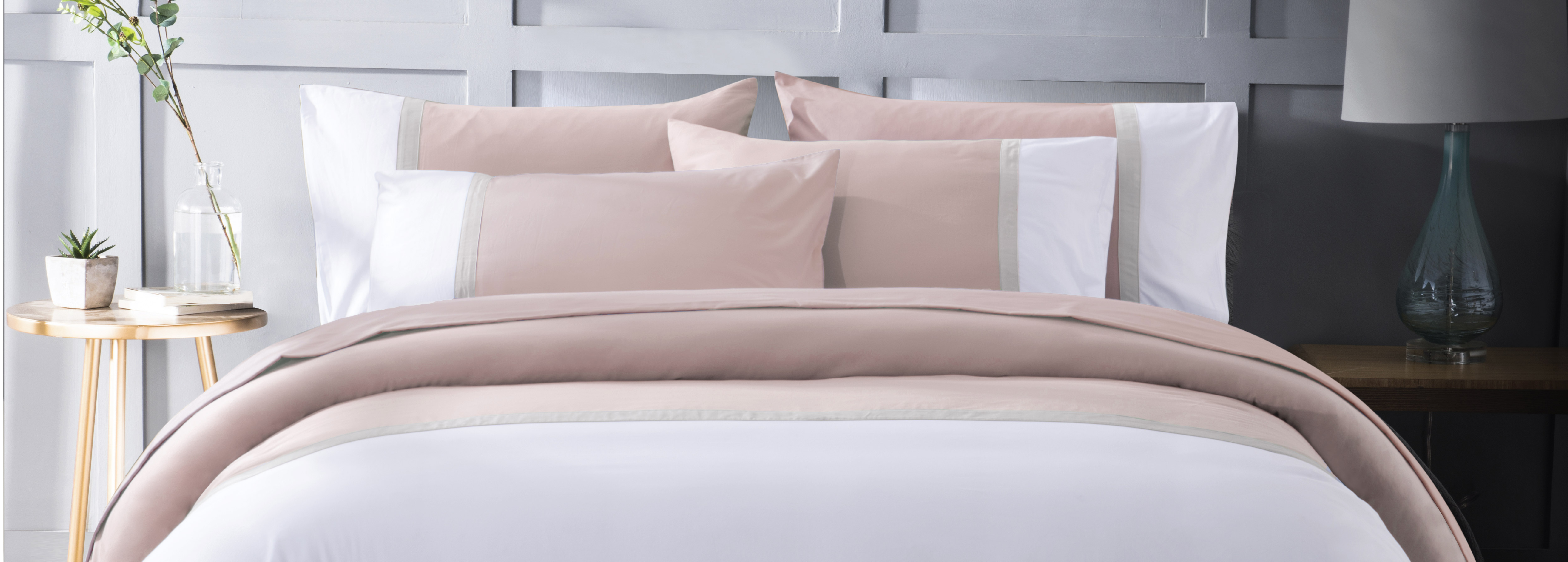Bed linen terminology

When describing our bed linen, we often use terminology specific to either the fabric used or the embellishments applied. Here is a simple guide to the most commonly used terms.
Quilt Cover
A quilt cover is designed to fit over and protect your desired quilt while adding colour and style to your bedroom. It can be easily removed for washing, saving the need to wash your quilt as often. Quilt covers are either sold separately or more frequently as a set.
Cotton
Cotton is a natural fibre - it breathes against your skin making it comfortable and cooler to sleep on or under. It is also non-allergenic, making it ideal for people with allergies. Cotton does, however, crease therefore it requires more care than a polyester/cotton blend
Polyester Cotton
Polyester cotton, shortened to poly/cotton is a blend of cotton and polyester fibres used in bed linen. Polyester, a synthetic or man-made fibre, helps increase the durability of the cotton and the life span of the product. Cotton keeps the product soft and comfortable to sleep on or under. Together they produce an `easy care` fabric.
Supima Cotton
Supima Cotton is one of the world`s finest cotton. It is superior to other cotton because it has fine, long fibres that can be spun to make softer, silkier and more durable textile products. The Supima Trademark is the consumer`s guarantee that the product is made from 100% American Pima Cotton. Pima cotton represents just 3% of annual cotton production in the US, therefore customers can be guaranteed that their Supima purchase is not only of the highest quality but is also exclusive due to its limited supply.
Egyptian Cotton
Egyptian cotton, grown in the Nile River Valley, is long fibred cotton that is spun into a fine yarn. The result is a very lightweight, fast-drying soft, yet durable fabric. Products made of Egyptian cotton are substantially lighter and more compact than those made of cotton. This is a good compromise between regular cotton and silk!
Types Of Weave:
The way in which fabric is woven also has an effect on its feel. Cotton sateen sheets, for example, are softer than those with a classic linen weave. A satin weave has more warp threads on the top surface, resulting in a silk-like touch and appealing lustre. Which is better? It`s a matter a personal taste; some people prefer the crispness of a linen weave, others like the softness of the satin.
Combed Cotton
Combing separates the long desirable fibres from the shorter fibres and other impurities in the cotton. This creates a stronger, smoother yarn.
Sateen
Cotton Sateen is created by using a special weaving process to place more lengthwise yarns on the surface of the fabric. This process produces a soft sheen to the fabric and a very soft feel.
Thread Count
Thread count refers to the number of threads woven into per square inch of fabric. The higher the thread count, the softer and more durable the fabric is. The thread count of standard cotton or muslin is around 150 whereas good quality sheets start at 180. A count of 200 and higher is referred to as "percale".
Thread count also relates to the quality of yarn and its construction. With finer threads, more can be woven into each square inch producing a finer, softer, more flexible fabric. Thread counts above 500 are something of a misnomer. Very high thread counts generally entail the use of a "plied yarn" - one that is produced by twisting together multiple fine threads. For marketing purposes it is not uncommon to count the twisted yarn as double which enables fabric with 250 individual four-ply yarns in a square inch to be described as 1,000 thread count product.
As you`ve just read, thread counts cannot always be relied upon to demonstrate a sheet`s softness and level of quality. Softness depends more on the quality of the fibre rather than the actual thread count. It is for this reason a 200 thread count fine cotton sheet can have a softer feel than a 400 thread count sheet that uses an inferior grade of cotton or a twisted thread.
While some claim thread count is the best way to choose bed linen, take note to remember the quality of cotton and the way a sheet will feel on your body is what matters most for a good night`s sleep.
Percale
Percale is a fabric with a minimum thread count of 200 threads per square inch.
